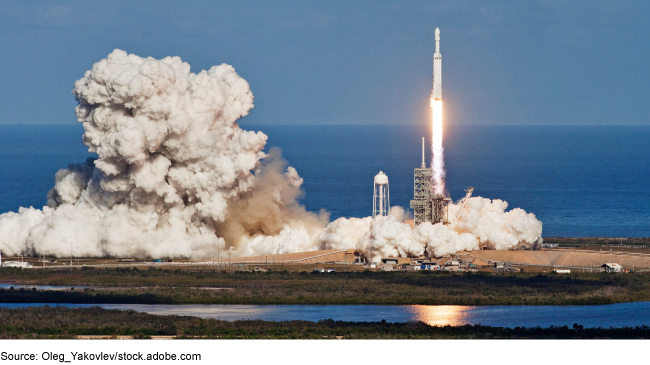Commercial Space Transportation: How FAA Considers Environmental and Airspace Effects
Fast Facts
Commercial space transportation companies use privately-owned launch vehicles to transport people and cargo, like satellites, to and from space. Commercial space operations enable essential activities such as digital communication and navigation.
The Federal Aviation Administration is responsible for licensing these companies. To do so, it assesses how their activities affect the environment.
In addition, before each launch, FAA also looks at how the launch may affect airplanes flying in the same area, which may need to be delayed or rerouted to avoid the launch vehicle's path.

Highlights
What GAO Found
As part of its oversight of the commercial space transportation industry, the Federal Aviation Administration (FAA) assesses the potential effects that launch or reentry activities would have on the environment. These environmental reviews are required by the National Environmental Policy Act and conducted before FAA issues a commercial space license. FAA policy requires these reviews to assess 14 categories, such as noise, coastal resources, and land use, for potentially significant impacts on the environment. To assess significance, FAA may conduct new reviews or reevaluate and use reviews that were previously completed for launch sites or other activities. GAO found that 19 of the 22 reviews FAA prepared for current launch and reentry license applications were based on previous environmental reviews for the original licensing effort. FAA concluded that the potential environmental impacts of these launch and reentry activities were either below significant levels or were mitigated to be below significant levels overall. For example, in one review, FAA found that emissions from fuel burn during takeoff could produce short-term air-quality impacts, but these impacts would be indistinguishable from the impacts of ongoing flight operations in the area.
According to FAA officials, approving or denying a license application based on the effects on other airspace users is not within FAA's statutory authority. However, during the licensing process, FAA begins to identify and plan for these effects while still ensuring operations meet safety criteria. These planning efforts include establishing procedures for communicating closures. Also, before granting a licensed operator's request for a specific launch time, FAA estimates the impact on other airspace users by using historical air traffic data to identify affected routes and the number of affected aircraft. In addition, FAA has reported decreasing the amount of time airspace is closed by using time-based management procedures. These procedures attempt to more efficiently identify aircraft projected to enter a hazard area when space operations occur to reduce re-routing.
Example of Airspace Closure for Commercial Space Launch

Why GAO Did This Study
Commercial space transportation enables essential activities such as digital communications, navigation, and weather forecasting. Since the first U.S.-licensed commercial space launch in 1989, the industry has expanded into a multibillion-dollar enterprise. U.S.-licensed launches and reentries have grown from 9 in 2012 to 124 in 2023. There are many benefits of commercial space transportation; however, its growth has implications for how FAA manages airspace around launches and reentries, and affects other airspace users, such as commercial airlines. Further, rocket launches emit gases and particles into the air, which can affect the environment.
GAO was asked to review the factors FAA considers as part of its licensing of commercial space launch and reentry operations. This report describes how FAA: (1) conducts environmental reviews for commercial space operations and what those reviews have found, and (2) considers the impacts on airspace users of airspace closures during licensing and launch and reentry operations.
GAO reviewed statutes, regulations, FAA guidance, and documentation from environmental reviews associated with each domestic commercial space vehicle launch and reentry license as of July 2023. GAO also interviewed FAA officials and commercial space stakeholders, including the National Aeronautics and Space Administration, the Department of Defense, and five associations representing the aviation and commercial space industries.
For more information, contact Heather Krause at (202) 512-2834 or KrauseH@gao.gov.
